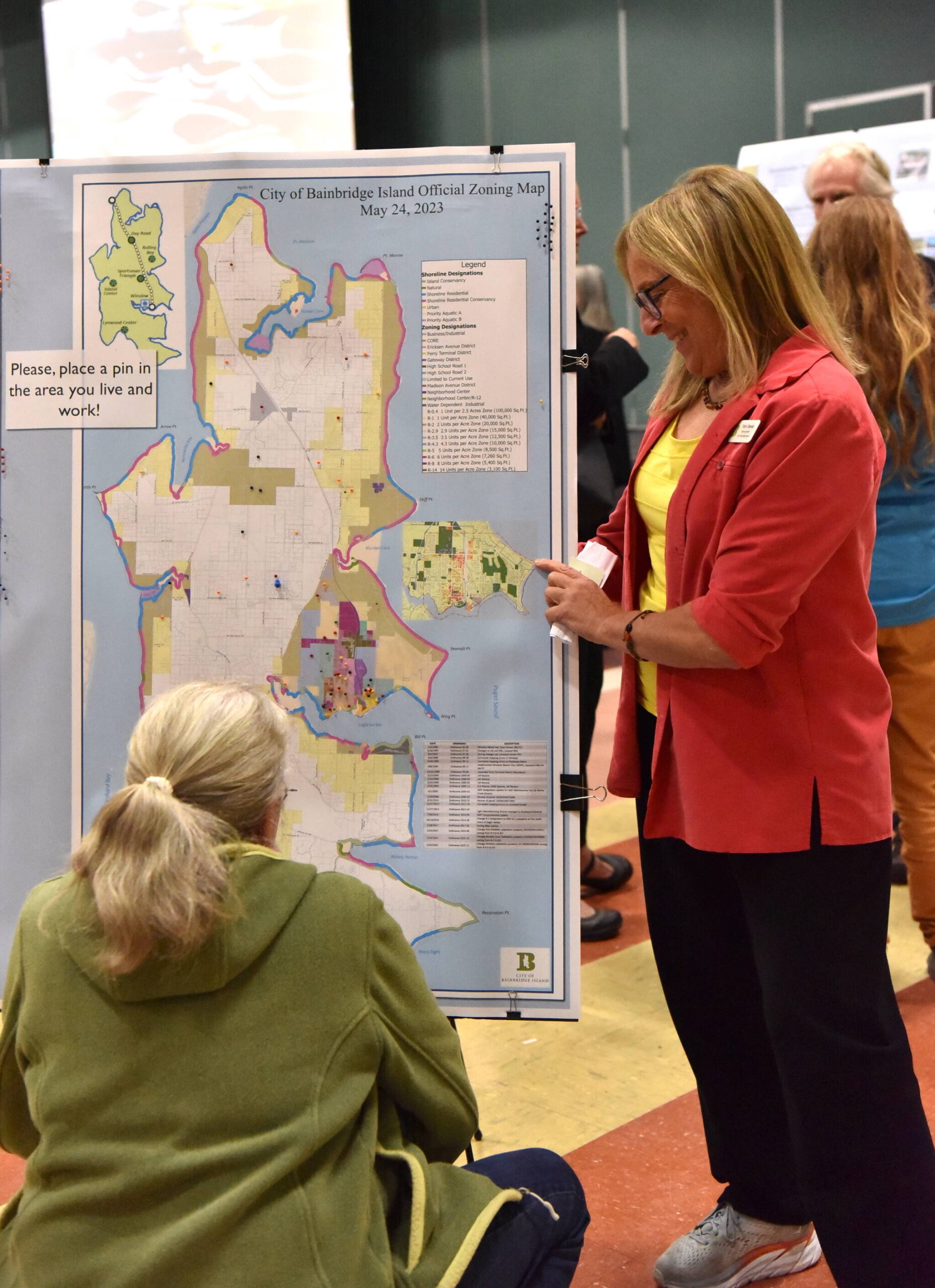Bainbridge Island’s future was on the minds of more than 90 community members who gathered at Woodward Middle School Sept. 27 for the first open house and workshop to give input for the BI Comprehensive Plan.
The state’s Growth Management Act mandates that the plan be updated every eight years.
The workshop started the public planning process and includes goals, policies, maps, actions, and capital improvements that guide growth toward that vision. The workshop helps the city consider land use, housing, capital facilities, utilities, transportation, economic and environmental issues.
“Your input and involvement in our community planning efforts tonight, particularly the Comprehensive Plan periodic update, is so important,” BI Planning director Patty Charnas said. Charnas added the Comp Plan and Winslow Subarea Plan work together and are essential because the state legislature has given local governments many new requirements.
Some of those requirements include accommodating more diverse, accessible and affordable housing types, and addressing permit review processes, land uses for accessory dwelling units, climate change and so on. “Fortunately, we have some time to comply, but we have to start getting that thought down. These great processes are the backbones to the rest of what we do and where we live, work and play,” she said.
Bill Grimes, an SCJ Alliance consultant, explained the task before the group.
Community members were asked to take a look at snippets from the vision and consider whether they are still relevant, then look for policy gaps to comply with the GMA and then consider any other elements that should be analyzed for adverse impacts such as land use, population and employment, housing, climate change and more.
The Comp Plan establishes the long-range vision for the island, identifying important characteristics that the community desires to retain, promote or foster. The Winslow Subarea Plan update will lead the way for the Winslow area first. The Comp Plan update will complete complementary planning for the areas outside of Winslow and island-wide issues.
Sharese Graham, an SCJ Alliance environmental consultant, said, “We want to know the concerns from a broader perspective for the whole city.”
After community members worked in small groups, they gave short presentations and shared their findings. Climate change, housing and health care were top concerns.
The Group 10 speaker said, “We have to make sure that we are paying attention to the intensifying external pressures from climate change on our environment. We think it’s climate change that is driving so much of everything in the environment, and we have to absolutely put climate change front and center.” That group also opposed high-rise buildings. “We’d like to see dense village clusters like in the UK and in Scandinavia instead of high rises. Our island is so beautiful and so desirable because we do not have them. We don’t want to become another Bellevue, period. There’s a high-level agreement already that that will be prevented to preserve the character integrity and beauty of our island.”
Regarding the policy gaps, Lynwood, Rolling Bay, Wing Point and other places were suggested areas for development instead of just Winslow.
Group 9 suggested that the island can develop as a national or international leader in environmental stewardship by taking responsibility for and addressing climate change.
Renni Bispham addressed community values and asked the groups to consider their priorities and what is valued when addressing housing and other issues before them. “If people are, in fact, more valued than something else, pick the one value that would allow more people to afford to live here. I hope that we would, as a community, value people over things,” Bispham said. “I think people should come first.”
Peter Bang-Knudsen, the Bainbridge schools superintendent, emphasized placing a higher value on housing. “We are down over 700 students in the last 18 years. The average age on Bainbridge Island has gone from 38 to 51 over the last 18 years. The correlation is, we don’t have enough housing for young families anymore. When we talk about values, if we value public education, we value our kids, we value our young families. We’re going to need to address housing in a serious way.”
Another group had issue with the vision statement. “We did not feel that it was super important or relevant that we were a national destination for artistic excellence,” Joe Chantry said. “We generally agreed on the commitment to the neighborhood centers and the villages idea, but having places that focus on retailers, local goods, small businesses and various types of housing, so that people of various walks of life, employment types and incomes can move here, live here, thrive here, have a family here.”
Rob “Buzz” Zalenski moved here six months ago, and he sees a need for more healthcare options. “Compassionate care, like hospice and palliative care, and aging in place are my two priorities. I’m a new resident, and I want to die here.”
Grimes said, “The community is getting into this at a level of detail and nuance that surprises me. They are coming up with dimensions and considerations that are pretty sophisticated.”
Residents may provide feedback online through Oct. 29 at www.bainbridgewa.gov/162/Comprehensive-Plan.



